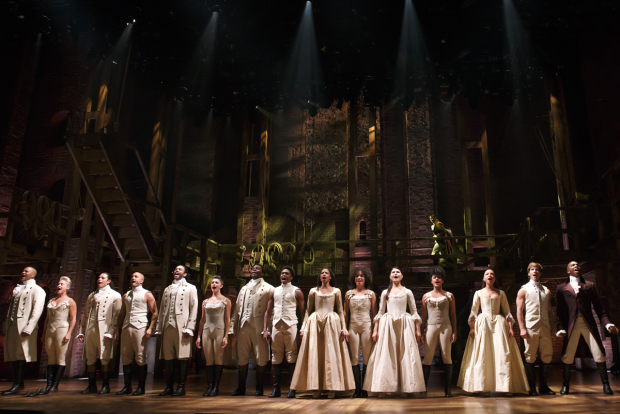Look Around: David Korins' Tony-Nominated Hamilton Set Isn't Just Brick and Wood
”Hamilton” is lucky 13 for Korins, a prolific designer of theater and beyond.

(© Seth Walters)
"I've made a career of people being like, 'Well, what's the set?'"
David Korins says this with a laugh, but there's a deep undercurrent of truth in his statement. Korins has designed the sets for 14 Broadway shows and countless other productions, all of which bear his signature: an impressive complexity in size and scope, yet with such subtlety that they often go unnoticed. After toiling in the business for more than a decade, creating the stately Pennsylvania lodge for Vanya and Sonia and Masha and Spike and even reimagining Pee-Wee Herman's playhouse along the way, Korins has only now received his first Tony nomination, for his thirteenth production, Lin-Manuel Miranda's Hamilton.
In the madness of Broadway's awards season, designers are not the most recognized people who walk the red carpets, but they are among the most important. After all, without the set or costumes or lighting, there would be no show. "One of the best compliments I've ever gotten," Korins remembers, "was from an actor who said to me, 'I don't have to do any character development work. When I walk onto your set, I know exactly who I am.' That's powerful."
Korins' firm, David Korins Design, is a "one-stop shop" that produces "three-hundred-sixty-degree experiences from the beginning of the customer journey to the end." Theater is only a small part of their creations, a list that includes restaurants, galleries, and concerts by Mariah Carey, Andrea Bocelli, and Kanye West. Korins even served as West's creative director for two years, primarily trying to help the music icon turn his album My Beautiful Dark Twisted Fantasy into a theater piece.
Designing from one medium to another helps keep things fresh. "You can take what you've learned working with a Kanye West or a Mariah Carey and put it into Hamilton," he says. "And then you can take what you learned from Hamilton and use it for Grease Live!, and then you can take what you learned from Grease Live! and use it in a restaurant. They are all the same to me: There is a collaborator, a restaurateur or a composer, and we talk about what they're trying to achieve, and how to use the tools we have to elicit a response from the audience. I think about what it is that you want the patron to walk away feeling, and how you want them to feel, and then you reverse engineer the experience."
Hamilton was the fifth collaboration between Korins and director Thomas Kail, but that doesn't mean Korins was a shoo-in for the job. "I'm the only person who worked on Hamilton that didn't work on In the Heights," Korins notes. "I got a copy of the music, which at the time was Lin singing all the parts, and I got a copy of the script, and I studied. I worked really hard. I don't normally do this [before being hired], but I did a scene breakdown, I did research, I did sketches. I responded to the music and really wanted an opportunity to work with this group of people on this story. I literally said, 'I'm not gonna throw away my shot' in the interview. 'We could be the Founding Fathers of the American theater.' And he gave me the job."
In typical fashion, there's more than meets the eye within his Tony-nominated creation. "The amount of work that went into designing Hamilton so people could go, 'It's a brick set!' We did seventy different versions. We had water, we had real dirt, we had unfinished floors, we had monuments to the men. We were going to do it in modern-dress. There was one [design] where there was a parchment floor and a huge quill they could climb up and use as a crow's nest on a ship. That was a bad idea."
As Korins puts it, "Designing is redesigning." They finally hit upon their magic idea with the knowledge that Miranda's musical would first be performed at the Public Theater, particular in the venue's hallowed Newman Theater, with exposed brick walls throughout the auditorium. A conversation with the Public's artistic director, Oskar Eustis, helped immeasurably as well. "Oskar said, 'I live in a house that was built by shipbuilders.' What you realize when you do research of that time is that everyone was basically an immigrant, and all the carpenters of the time built boats." The Hamilton set, with its exposed brick and wood, pulleys and ropes, lap joints and pegs, is nautical in nature, "which is elegant because we're talking about an immigrant coming over the water."
Even the nitty-gritty took a significant effort to get right. "We went through thirty-three different colors of brick to get the complexion of the skin to look perfect against the complexion of the brick." And the pair of turntables at the center took more work on the automation end. "For every page of script, there is about an hour to two hours of tech time. It might take nine seconds [for the turntable] to get up to speed, it travels at top speed for thirty-one seconds, and then it reduces in order to end perfectly at that spot. And people are like, 'Right, the floor's moving.'"
Viewers can see the various stages of his Hamilton designs on his Instagram account, which is specifically curated to "give a voice to the voiceless," the designers whose work is rarely considered by regular audiences. "I wanted to show people that we didn't just make Hamilton." It's also a personal tool, one to show his two young daughters that "hard work and thoughtfulness actually wins the day."
Thoughtfulness might not be the most glamorous choice, but that's OK. "When you're a designer," he says, "you have the ability to make, in quotation marks, cool things." His all-encompassing research could have created a replica of the Schuyler Mansion or New York City itself, circa 1776. But his sure-to-become iconic creation for Hamilton suits the material best because it hits at the heart of the piece. "To cut against your impulses to show off, to just wrestle with the narrative in creating a place that could talk about the progress and the building of the country, was a beautiful challenge."
Korins' plate is a full one. Aside from the forthcoming Chicago production of Hamilton, he's also designing the sets for War Paint, with Patti LuPone and Christine Ebersole, as well as the Broadway transfers of Dear Evan Hansen and The Bandstand. His non-show commitments include creating the environment for the theater district eatery Bond 45, in its new location across the street from Hamilton's home at the Richard Rodgers Theatre.
"My whole life has become a pinch-me moment," he concludes. "It's a huge honor and responsibility. I love my job, but it is not lost on me for a second, the profundity of how lucky I am to want to try this career and get the opportunity to do it. It's super cool and lovely."

(© Joan Marcus)








